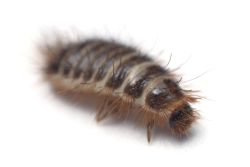 Description:
Description:
Carpet beetles are a fairly common pest. Though these insects will do damage to fabric, they are known to be a pest in food products as well. Carpet beetles occur naturally outdoors and then make their way into buildings. They may enter through improperly sealed or improperly screened doors and windows or through other cracks or crevices, but due to their small size, sealing them out is completely is difficult. Carpet beetles, which belong to the family of beetles known as dermestids, are pests in warehouses, homes, museums, and other locations where suitable food exists. Three species of carpet beetles cause serious damage to fabrics, carpets, furs, stored food, and preserved specimens—the varied carpet beetle, the furniture carpet beetle, and the black carpet beetle. Adult beetles can usually be found in groups and are attracted to daylight, so keep an eye on window sills and any other bright places in your home. Damage to carpets and clothes – even though carpet beetles, like moths, enjoy the natural fibers of wool, leather, etc., they will also cause damage in materials or items that have natural fibers as part of its content.
Appearance:
Adults are 3/16""–1/4"" long. Elongate oval. There is one small patch of white on each wing case, otherwise red-brown to black. Larva is 1/4"" long. Long orange tufts of hair on the last abdominal segment. Larvae have a banded appearance. Pupa — formed in the last larval skin.
Lifecycle:
Mating takes place outdoors after which they fly indoors to lay eggs. Normally one generation per year but development may extend to three years.
Habits:
It is a common inhabitant of bird nests. Adults feed outdoors often on Spiraea plants. Larvae attack furs, skins, woolens, etc. and stored grain. Fur beetles do not carry disease and do not bite, therefore are not considered a risk to human health. Sometimes when there are large numbers of beetles the hairs on the larvae may cause skin irritations for some people, damaged carpets, and clothes. Preventing tips: Regularly vacuuming hard-to-reach places, with particular care paid to under heaters or radiators, as well as at the point where skirting boards meet. If you are storing items made from natural fibers, such as wool, ensure they are vacuumed packed and tightly sealed in plastic bags. It is also necessary checking them periodically if you are storing them for a long time.






